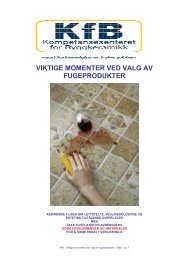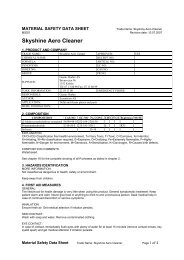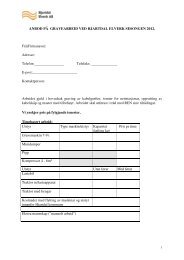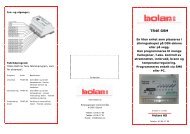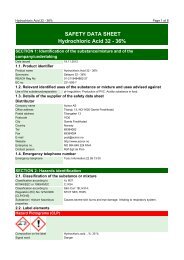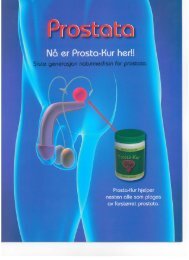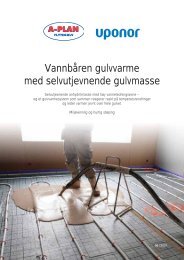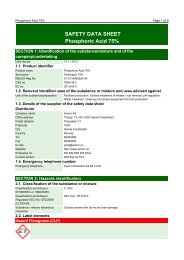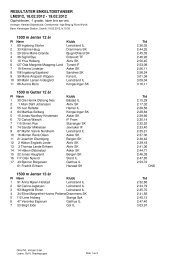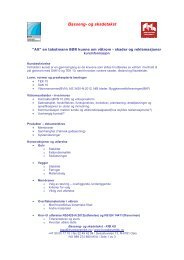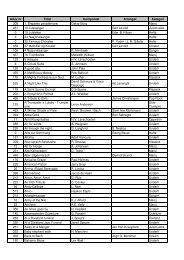SAFETY DATA SHEET Potassium Sulphate
SAFETY DATA SHEET Potassium Sulphate
SAFETY DATA SHEET Potassium Sulphate
You also want an ePaper? Increase the reach of your titles
YUMPU automatically turns print PDFs into web optimized ePapers that Google loves.
<strong>Potassium</strong> <strong>Sulphate</strong> Page 2 of 8S46 If swallowed, seek medical advice immediately and show this containeror label.Composition on the label <strong>Potassium</strong> hydrogensulphate: 10 - 15 %2.3. Other hazardsPBT / vPvBHealth effectPBT/vPvB assessment has not been performed.Prolonged or repeated exposure may cause permanent damage.SECTION 3: Composition/information on ingredients3.2. MixturesComponent name Identification Classification Contents<strong>Potassium</strong> sulfate CAS no.: 7778-80-5EC no.: 231-915-5<strong>Potassium</strong> hydrogensulphate CAS no.: 7646-93-7EC no.: 231-594-1Index no.: 016-056-00-4Remark, componentComponent commentsSECTION 4: First aid measures4.1. Description of first aid measuresGeneralIf in doubt, seek medical advice.InhalationSkin contactEye contactIngestionC; R34Xi; R37Skin Corr. 1B; H314STOT SE 3; H335> 85 %10 - 15 %CAS-nr.:7778-80-5 Reach Reg.nr.:01-2119489441-34.On grounds of experience and test data, the classification for this preparationis less stringent than the one imposed by the criteria referred to in theNorwegian regulation on classification and labeling of dangerous chemicals.Valid from June 21, 2010.See section 16 for explanation of H- and R-phrases listed above.Remove victim immediately from source of exposure. Rinse nose and mouthwith water. Fresh air and rest. Get medical attention if any discomfortcontinues.Remove contaminated clothing. Wash the skin immediately with soap andwater. Get medical attention if any discomfort continues.Immediately flush with plenty of water for up to 15 minutes. Remove anycontact lenses and open eyes wide apart. By prolonged rinsing, use lukewarm water to avoid damage to the eye. Transport to physician. Keep onflushing during transport.Rinse mouth thoroughly with water and give large amounts of milk or waterto people not unconscious. Do not induce vomiting. Seek medical attention.4.2. Most important symptoms and effects, both acute and delayedInformation for health personnel Treat Symptomatically.Acute symptoms and effectsDelayed symptoms and effectsInhalation: May cause respiratory irritation.The product may irritate skin and cause itching, burning and redness. Skinrash/inflammation.Risk of serious damage to eyes. May cause severe burning and pain in theeyes.Ingestion: May irritate and cause stomach pain, vomiting and diarrhoea.Prolonged or repeated exposure may cause permanent damage.4.3. Indication of any immediate medical attention and special treatment neededOther Information No specific treatment required, see section 4.1.SECTION 5: Firefighting measures5.1. Extinguishing mediaSuitable extinguishing mediaImproper extinguishing mediaUse fire-extinguishing media appropriate for surrounding materials.Do not use water jet.
<strong>Potassium</strong> <strong>Sulphate</strong> Page 3 of 85.2. Special hazards arising from the substance or mixtureFire and explosion hazardsThe product is not classified as flammable.Hazardous combustion products Toxic and corrosive gases/vapours. Oxides of sulphur (SOx).5.3. Advice for firefightersOther InformationContainers close to fire should be removed immediately or cooled with water.Extinguishing water must not be discharged into drains.SECTION 6: Accidental release measures6.1. Personal precautions, protective equipment and emergency proceduresPersonal precautions Use protective equipment as referred to in section 8.Provide adequate ventilation.6.2. Environmental precautionsEnvironmental precautionsDo not allow to enter into sewer, water system or soil.6.3. Methods and material for containment and cleaning upMethods for cleaningCleaning up6.4. Reference to other sectionsOther instructions See also sections 8 and 13.SECTION 7: Handling and storage7.1. Precautions for safe handlingHandlingProtective MeasuresMeasures To Prevent fireAdvice on general occupationalhygieneStop dust cloud by humidifying. Use mechanical handling equipment. Collectin a suitable container and dispose as hazardous waste according to section13.Wash the contaminated surface with water.Provide adequate ventilation. Use protective equipment as referred to insection 8.Container must be kept tightly closed.Avoid contact with skin and eyes.Use work methods which minimise aerosol production.Change contaminated clothing.Keep away from sources of ignition.Wash hands at the end of each work shift and before eating, smoking andusing the toilet. Do not eat, drink or smoke during work.7.2. Conditions for safe storage, including any incompatibilitiesStorageStore dry and cool in a well ventilated area. Store in tightly closed container.Conditions To AvoidAvoid heat.Requirements for storage roomsand vesselsHints on storage assembly7.3. Specific end use(s)Specific use(s) See section 1.2.Use storage tank made of: Glass or ceramic material.Unsuitable containers: aluminium. Metal.Keep away from: Metals. Strong alkali.SECTION 8: Exposure controls/personal protection8.1. Control parametersExposure limit valuesComponent name Identification Value YearTotal inhalable dust 8 h.: 10 mg/m³ 2010Respirable dust 8 h.: 5 mg/m³ 2010
<strong>Potassium</strong> <strong>Sulphate</strong> Page 4 of 88.2. Exposure controlsOccupational exposure controlsRespiratory protectionRespiratory protectionHand protectionHand protectionSuitable gloves typeBreakthrough timeAdditional hand protection measuresProvide adequate ventilation. Personal protection equipment should be chosenaccording to the CEN standards and in discussion with the supplier of thepersonal protective equipment.In case of inadequate ventilation or risk of inhalation of dust, use suitablerespiratory equipment with particle filter (type P2).Use chemical resistant gloves.Nitrile. Butyl rubber. Neoprene.Penetration time is not known. The recommended material of gloves isrecommended after a study of the single components in the product.Change gloves frequently.Eye / face protectionEye protectionWear dust resistant safety goggles where there is danger of eye contact.Skin protectionSkin protection (other than of the Wear appropriate clothing to prevent any possibility of skin contact.hands)Appropriate environmental exposure controlEnvironmental exposure controls Do not allow to enter into sewer, water system or soil. See also section 12.Other InformationOther InformationEye wash facilities must be available when handling this product. Emergencyshower should be available at the workplace. The listed protective equipmentis a recommendation. A risk assessment of the actual risk may lead to otherrequirements.SECTION 9: Physical and chemical properties9.1. Information on basic physical and chemical propertiesPhysical stateCrystalline powder.ColourWhite. / Colourless.OdourNo characteristic odour.Comments, Odour limitNot available.Comments, pH (as supplied) Acidic.Comments, pH (aqueous solution) Not entered.Comments, Melting point / meltingrangeComments, Boiling point / boilingrangeComments, Flash pointComments, Evaporation rateFlammability (solid, gas)Comments, Explosion limitComments, Vapour pressureComments, Vapour densitySpecific gravityComments, Specific gravitySolubility in waterComments, Partition coefficient: n-octanol / waterComments, SpontaneouscombustabilityComments, DecompositiontemperatureNot entered.Not entered.Not entered.Not entered.Not entered.Not entered.Not entered.Not entered.Value: > 2,3 g/cm³Valid for density.Soluble.Not entered.Not entered.Not entered.
<strong>Potassium</strong> <strong>Sulphate</strong> Page 5 of 8Comments, ViscosityPhysical hazardsExplosive propertiesOxidising propertiesNot entered.Not entered.Not entered.9.2. Other informationOther physical and chemical propertiesCommentsNo further information is available.SECTION 10: Stability and reactivity10.1. ReactivityReactivity10.2. Chemical stabilityStability10.3. Possibility of hazardous reactionsPossibility of hazardous reactionsHazardous polymerization will not occur.Stable under normal temperature conditions and recommended use.Arise in contact with incompatible materials (section 10.5) and inappropriateconditions (section 10.4).10.4. Conditions to avoidConditions to avoidAvoid heat.10.5. Incompatible materialsMaterials to avoidMetals. Strong bases.10.6. Hazardous decomposition productsHazardous decomposition products None under normal conditions. See also section 5.2.SECTION 11: Toxicological information11.1. Information on toxicological effectsToxicological Information:LD50 oralLD50 oralLD50 oralOther information regarding health hazardsGeneralPotential acute effectsInhalationSkin contactEye contactIngestionDelayed effects / repeated exposureSensitisationCarcinogenic, Mutagenic or ReprotoxicValue: 2340 mg/kgTest animal species: RatComments: Toxic dose. Apply to CAS-n.:7646-93-7.Value: 6600 mg/kgTest animal species: RatComments: Toxic dose. Apply to CAS-n.:7778-80-5.Value: > 2000 mg/mkgTest animal species: RatComments: Toxic dose.This substance is corrosive. Prolonged exposure to the preparation may causeserious health effects.Dust may irritate respiratory system or lungs.The product may irritate the skin. Symptoms such as redness and itching ofthe skin may occur. May cause rash/inflammation.Risk of serious damage to eyes. Immediate first aid is necessary. May causesevere burning and pain.May irritate and cause stomach pain, vomiting and diarrhoea. May causedecreased renal function, and disturbances of heart rate.None of the substances mentioned in section 3 is considered to havesensitizing effects according to current labelling rules.
<strong>Potassium</strong> <strong>Sulphate</strong> Page 6 of 8CarcinogenicityMutagenicityTeratogenic propertiesReproductive toxicitySECTION 12: Ecological information12.1. ToxicityAcute aquatic, fishAcute aquatic, fish, CommentsAcute aquatic, DaphniaEcotoxicityNone of the substances mentioned in section 3 is considered as carcinogenicaccording to current labelling rules.None of the substances mentioned in section 3 are considered to havemutagenic or pro-mutagenic effects.None of the substances mentioned in section 3 are considered to cause harmto the unborn child.None of the substances mentioned in section 3 are considered to havegenotoxic effects.Value: 653-796 mg/lMethod of testing: LC50Fish, species: Lepomis MacrochirusDuration: 96 hoursTest reference: CAS-nr.: 7778-80-5Value: 3500 mg/lMethod of testing: LC50Fish, species: Leuciscus IdusDuration: 96 hoursTest reference: CAS-nr.: 7646-93-7Value: 890 mg/lDaphnia, species: Daphnia MagnaDuration: 48 hoursTest reference: CAS-nr.: 7778-80-5The product components are not classified as environmentally hazardous.However, this does not exclude the possibility that large or frequent spills canhave a harmful or damaging effect on the environment.12.2. Persistence and degradabilityPersistence and degradability The product contains inorganic compounds that are not biodegradable.12.3. Bioaccumulative potentialBioaccumulative potentialProduct is not expected to be bioaccumulative.12.4. Mobility in soilMobilityThe product is soluble in water.12.5. Results of PBT and vPvB assessmentPBT assessment resultsPBT assessment has not been performed.vPvB evaluation resultsvPvB assessment has not been performed.12.6. Other adverse effectsOther adverse effects / RemarksSECTION 13: Disposal considerations13.1. Waste treatment methodsSpecify the appropriate methods ofdisposalProduct classified as hazardouswastePackaging classified as hazardouswasteEWC waste codeDo not allow to enter into sewer, water system or soil.Not dangerous for the ozone layer.Disposed of as hazardous waste by approved contractor. The waste code(EWC-Code) is intented as a guide. The code must be chosen by the user,if the use differs from the one mentioned above.YesYesEWC: 06 01 06 other acidsEWC: 15 01 10 packaging containing residues of or contaminated bydangerous substances
<strong>Potassium</strong> <strong>Sulphate</strong> Page 8 of 8Further informationSources of key data used tocompile the safety data sheetInformation which has been added,deleted or revisedChecking quality of informationResponsible for safety data sheetPrepared byvPvB: very Persistent and very BioaccumulativeLC50: Concentration in water having 50% chance of causing death to aquaticlifeLD50: Lethal dose, is the amount of a substance given to a group of testanimals, which causes the death of 50%.EC50: Median Effective Concentration, required to induce a 50% effectOn grounds of experience and test data, the classification for this preparationis less stringent than the one imposed by the criteria referred to in theNorwegian regulation on classification and labeling of dangerous chemicals.Valid from June 21, 2010Suppliers Safety data sheet dated: 17.04.2011New Safety Data Sheet.This SDS is quality controlled by National Institute of Technology in Norway,certified according to the Quality Management System requirements specifiedin ISO 9001:2008.Acinor ASNational Institute of Technology as, Norway v/ Camilla M. Ormset




